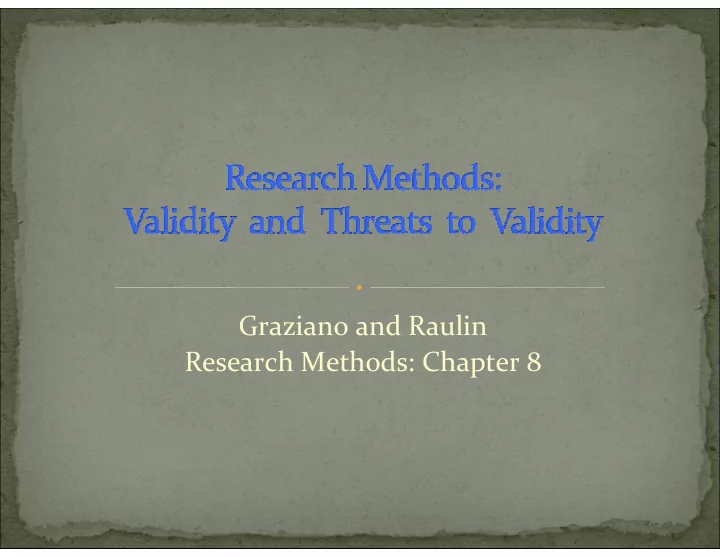

Graziano and Raulin Research Methods: Chapter 8
� Ideas lead to � observations � library research � Statement of problem � Problem statements become research hypotheses when constructs are operationalized
“FINER FINER” ” “ F Feasible I Interesting N Novel E Ethical R Relevant
� Actually testing three sets of hypotheses � The null hypothesis � The confounding variable hypotheses � The causal hypothesis � Accept causal hypothesis only if you � reject null hypothesis (statistical analysis) � rule out each potential confounding variable hypothesis (based on appropriate controls)
� Correlation (also called covariation) � Relationship found between variables � Time order � Cause must occur before result � Nonspuriousness � Alternative explanations must be eliminated from possibility � Experiments are intended to reduce or rule out alternative explanations and confounding variables
The PICO format: P Population I Intervention or Interest area C Comparison intervention or status O Outcome
“What is the usefulness or accuracy of the current 1-10 pain scale assessment in treating a patient’s pain, and what are other options that may prove more useful?” Does a 10 point pain Visual Analog Scale (____, ____) accurately assess pain in the first day postop abdominal total hysterectomy patient when compared with the Faces Pain Scale (Pasaro, 1997)?
� Statistical Validity – carrying out the actual statistical analysis properly � Construct Validity refer most often to a characteristic of an instrument but also to the whole study � External Validity refers to the generalizability of study findings � Internal Validity refers to a characteristic of a study’s design
� Are the statistical tests accurate? � Threatened by � Unreliable measures � Violations of statistical assumptions � How do we detect these problems??? � Strengthened by � Using well validated measures � Having approximately equal sample sizes in each group )
� Is our theory the best explanation for the results? � Threatened by � Any alternative explanation for the results � HOW do we locate these alternative explanations? � Strengthened by � Using well-validated constructs to build the theoretical predictions for the study
� Do the results apply to the broader population? � Threatened by � Unrepresentative samples � Generalizing beyond the limits of the sample � HOW do we know when this problem is present??? � Strengthened by � Gathering a representative sample (if possible) � Clearly describing sample, so that other researchers will know the limits of generalization
� Is the independent variable responsible for the observed changes in the dependent variable ? � Threatened by � Confounding variables � HOW do we detect the presence of confounding variables???? � Strengthened by � Adding adequate controls to reduce or eliminate confounding
� Confounding and internal validity � Many sources for confounding (covered next) � With proper controls, confounding can be virtually eliminated (see Chapter 9) � Confounding and construct validity � Make sure that you have considered alternative theoretical explanations for the anticipated phenomenon � HOW????
� Single-group, pretest-posttest design compares pre-treatment and post-treatment scores to determine improvement � Fails to control most sources of confounding
� Historical Historical events may occur during the course of the � experiment. � Remember Pygmalion effect & its story � Maturation Maturation of the subjects. � � Testing Testing and retesting can � influence awareness of variables or behavior � Learn Hawthorne effect & its story. � Instrumentation Instrumentation – measurement methods or � procedures may not be equivalent
� Statistical regression Statistical regression of � subjects starting out in extreme positions. � Selection Selection biases � (we will see several types) � Experimental mortality Experimental mortality � (a.k.a. attrition) – (a.k.a. attrition) subjects drop out of the study before it's finished. � Sequence effects Sequence effects – Performance on one measure is � related to previous experience with other measures. Outcome depends on the sequence of measures.
� Demoralization Demoralization subjects in � control group find out, lose interest in study, stop trying � Diffusion Diffusion of treatment (those � who get the experimental stimulus spread it to controls) � Rivalry Rivalry (controls change � behavior to try to beat the experimental group) � Equalization Equalization of treatment � (researcher compensates controls for not getting treatment)
� Participants are not passive � They try to understand the study to help them to know what they “ should do ” (termed subject effects subject effects ) � Respond to subtle cues about what is expected (termed demand characteristics ) demand characteristics � Placebo effect Placebo effect : treatment effect due to � expectations that the treatment will work
� Based on the expectations of the researcher � Can affect the outcome of studies if not controlled � May be due to the experimenter providing demand characteristics to the participant � Not the same as scientific fraud (which is deliberate)
� Three closely-tied concepts � Validity Validity � � The accuracy of the study or procedure � Increased by using appropriate control procedures � The more controls we employ, the higher the level of constraint � Controls may increase some types of validity while, by their unnatural aspect, decreasing other types of validity.
� Risk is balanced by reward � A poorly designed study will provide no useful information; therefore, any risk would be unacceptable � Informed Consent � Virtually guarantees that you will have confounding due to selection because some people will refuse to participate � A small price to pay to maintain ethical standards
� Start by building a research hypothesis � Testing the research hypothesis is actually testing three hypotheses � (1) null; (2) confounding-variable; (3) causal � Several types of validity � Many potential confounding variables � Subject and experimenter effects can also affect the outcome of the study
Recommend
More recommend